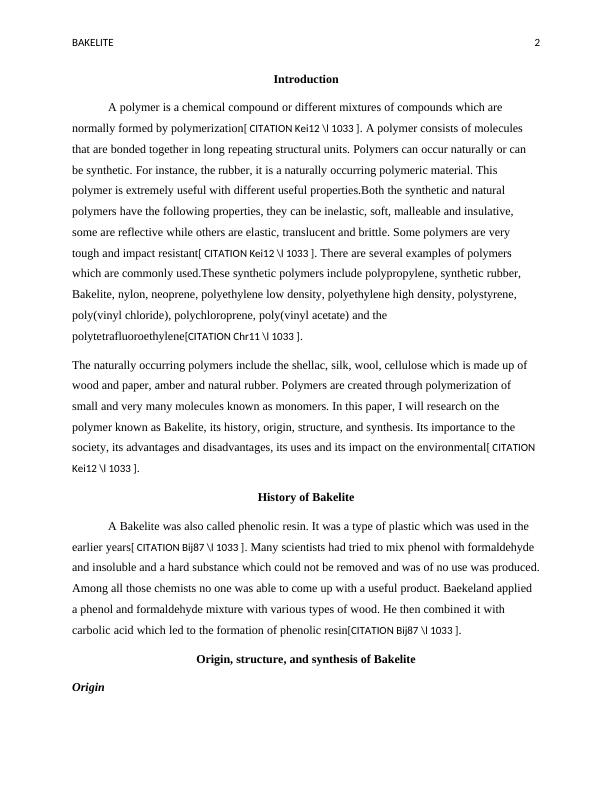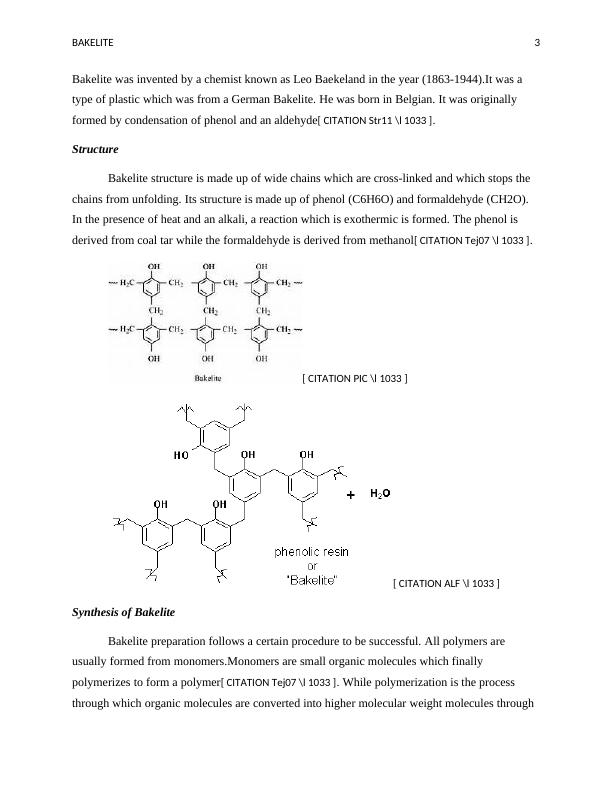Ask a question from expert
Research on Bakelite Polymer
7 Pages1777 Words406 Views
Added on 2020-05-03
Research on Bakelite Polymer
Added on 2020-05-03
BookmarkShareRelated Documents
Running head: BAKELITE1Bakelite

BAKELITE 2IntroductionA polymer is a chemical compound or different mixtures of compounds which are normally formed by polymerization[ CITATION Kei12 \l 1033 ]. A polymer consists of molecules that are bonded together in long repeating structural units. Polymers can occur naturally or can be synthetic. For instance, the rubber, it is a naturally occurring polymeric material. This polymer is extremely useful with different useful properties.Both the synthetic and natural polymers have the following properties, they can be inelastic, soft, malleable and insulative, some are reflective while others are elastic, translucent and brittle. Some polymers are very tough and impact resistant[ CITATION Kei12 \l 1033 ]. There are several examples of polymers which are commonly used.These synthetic polymers include polypropylene, synthetic rubber, Bakelite, nylon, neoprene, polyethylene low density, polyethylene high density, polystyrene, poly(vinyl chloride), polychloroprene, poly(vinyl acetate) and the polytetrafluoroethylene[CITATION Chr11 \l 1033 ].The naturally occurring polymers include the shellac, silk, wool, cellulose which is made up of wood and paper, amber and natural rubber. Polymers are created through polymerization of small and very many molecules known as monomers. In this paper, I will research on the polymer known as Bakelite, its history, origin, structure, and synthesis. Its importance to the society, its advantages and disadvantages, its uses and its impact on the environmental[ CITATION Kei12 \l 1033 ].History of BakeliteA Bakelite was also called phenolic resin. It was a type of plastic which was used in the earlier years[ CITATION Bij87 \l 1033 ]. Many scientists had tried to mix phenol with formaldehyde and insoluble and a hard substance which could not be removed and was of no use was produced.Among all those chemists no one was able to come up with a useful product. Baekeland applied a phenol and formaldehyde mixture with various types of wood. He then combined it with carbolic acid which led to the formation of phenolic resin[CITATION Bij87 \l 1033 ].Origin, structure, and synthesis of BakeliteOrigin

BAKELITE 3Bakelite was invented by a chemist known as Leo Baekeland in the year (1863-1944).It was a type of plastic which was from a German Bakelite. He was born in Belgian. It was originally formed by condensation of phenol and an aldehyde[ CITATION Str11 \l 1033 ].Structure Bakelite structure is made up of wide chains which are cross-linked and which stops the chains from unfolding. Its structure is made up of phenol (C6H6O) and formaldehyde (CH2O). In the presence of heat and an alkali, a reaction which is exothermic is formed. The phenol is derived from coal tar while the formaldehyde is derived from methanol[ CITATION Tej07 \l 1033 ].[ CITATION PIC \l 1033 ][ CITATION ALF \l 1033 ]Synthesis of BakeliteBakelite preparation follows a certain procedure to be successful. All polymers are usually formed from monomers.Monomers are small organic molecules which finally polymerizes to form a polymer[ CITATION Tej07 \l 1033 ]. While polymerization is the process through which organic molecules are converted into higher molecular weight molecules through

End of preview
Want to access all the pages? Upload your documents or become a member.
Related Documents
Polymers Cellulose Historylg...
|10
|2404
|360